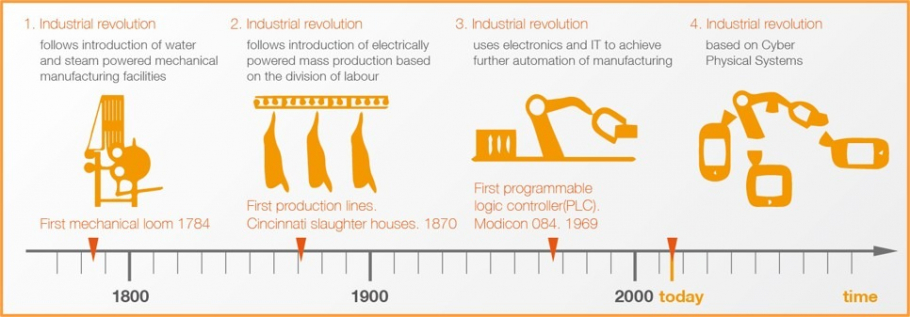MMTechnoSys

"Where Mind Shapes Technology"
INDUSTRY
Major trends in industrial evolution
What is Industry 4.0?
The industrialization has seen revolution after revolutions in every decade since its evolution in the 18th century. From the advent of steam power inventions to the introduction of electricity a century later, to the third industrial revolution in the 1970's with the advances in computing, till today where Industry 4.0 has brought in the Fourth Industrial Revolution that is transforming the economy, jobs, and society.
The term Industry 4.0 refers to the combination of several major innovations in digital technology, all coming to maturity right now, all poised to transform the energy and manufacturing sectors. These technologies include advanced robotics and artificial intelligence; sophisticated sensors; cloud computing; the Internet of Things; data capture and analytics; digital fabrication (including 3D printing); software-as-a-service and other new marketing models; smartphones and other mobile devices; platforms that use algorithms to direct motor vehicles (including navigation tools, ride-sharing apps, delivery and ride services, and autonomous vehicles); and the embedding of all these elements in an interoperable global value chain, shared by many companies from many countries.
Advantages of Industry 4.0
Industry 4.0 are designed to change the whole equation of manufacturing by providing greater agility without sacrificing the quality, cost and speed. Let’s discuss some of the advantages that Industry 4.0 brings along to manufacturing.
- Efficiency – Industry 4.0 bring in automation, which means fewer people. Therefore the decision making is faster, and the end product is of high quality and boosts efficiency.
- Agility- When the product is aware of its specification, the manufacturing process is accelerated. Industry 4.0 builds that intelligence in the system and fosters agility.
- Innovation- When the manufacturing unit can accommodate new product introduction and experimentation in design, it creates a space for change. Industry 4.0 production line enables more in-depth understanding of both product and process design.
- Customer Experience- Industry 4.0 provides comprehensive information and responsiveness available to manufacturers, thus allowing them to serve their customers better. Costs- Industry 4.0 requires an initial investment. Once the intelligence I built in the process and the product, the cost will scale down to negligible.
- Revenues- Fixing all the above method, Industry 4.0 can only promise to put the manufacturer in the limelight of the best suppliers list. This opens ways to serve the larger market, offer higher margin exceptional products, and operations that provide services to accompany these products.
Industry 4.0 Implementation Challenges
Anticipating the way technology is influencing our day to day life, no one can escape the Industry 4.0 revolution- the current trend of application of digital technologies in the industrial production chain. However, implementing Industry 4.0 has many challenges of its own.
- IT security issues
- Reliability and Stability needed for critical M2M communication
- Maintaining the integrity of the production process
- Avoid expensive production outrage (IT)
- Lack of sufficient skillsets
- Lack of regulation, standard and forms of certification
- Loss of manual jobs to the process of automation
Impact of Industry 4.0
Industry 4.0 is a solution to many challenges like resource and energy efficiency, urban production and demographic change. It enables continuous production, efficiency gains and organized cost management to the entire value network of production. Considering that there is a shortage of skilled workers in the industry, this smart assistance will take over all the routine task, enabling the available skilled workers to focus on creative, value-added activities and develop better professional and work-life balance.






